Multiple Choice
Identify the
choice that best completes the statement or answers the question.
|
|
|

Fidel
Castro
Communist Dictator of Cuba | Cuba 1959 -
1962
The emergence of a
communist government in Cuba heightens Cold War tensions -- and for several terrifying days brings
the world to the brink of nuclear war.
Cuba is only 90 miles from the United States, closer than
San Diego to Los Angels. Castro is still in power in Cuba and in the years since he took power,
thousands have fled Cuba for the United States to escape Communism (including Castro’s own
sister).
Castro claims that he does not want the United States to have influence in Cuba. He
hates American Capitalism. Yet, during the Cold War, he allowed the Soviet Union to use Cuba as a
base and he was little more than a Communist puppet.
Today, without the Soviet Union to back him,
he is little more than a joke on the world scene, except to the people of Cuba
| | |
|
|
|
1.
|
Castro is a
_____
a. | Capitalist | c. | National Socialist | b. | Communist | d. | Libertarian |
|
|
|
2.
|
Why is Cuba important to the
United States and why was it a threat during the Cold War?
a. | Cuba has a large amount of natural
resources and wealth | c. | It is only 90
miles from the U.S. and a Communist client of the Soviet Union | b. | Cuba has an army that rivals the U.S. Army and is close
enough to attack the U.S. | d. | All of these are
true |
|
|
|
REVOLUCION
Throughout the 1940s and '50s, the Caribbean island
of Cuba had many resorts and hotels and was a playground for the United States. Americans invested a
great deal of money in Cuba so some Cuban land and industry was owned or controlled by Americans.
Fidel Castro organized guerrilla forces and fought against the dictatorship of Cuban leader
Fulgencio Batista Many Americans supported Castro and sent him money and supplies.
Revolutionary
forces headed by Fidel Castro entered Havana in January 1959. Castro declared that he was a Communist
and began to seize American property in Cuba.
More than 500 people were tried and executed in a
show trial in the Havana Sports Arena. After appearing before the revolutionary judges the people
were executed on the spot. Thousands fled to exile in the United States. But to many Cubans, Castro
was a hero.
Many Americans, who
had supported Castro as the “Robin Hood” of Cuba, felt betrayed when he announced he was
a communist. |
 Cuban Communist Revolutionaries Cuban Communist Revolutionaries | | |
|
|
|
3.
|
Why did many Americans feel
betrayed by Castro?
a. | He did not announce to the Americans
that he was a Communist until after he took power. | c. | He owned a great deal of land and industry in
Cuba | b. | He was a supporter of Bautista, the dictator of
Cuba | d. | He announced to the Americans that he was a Communist
before he took power but Americans did not believe him. |
|
|
|
4.
|
Who were tried and executed by
the Castro Communists in the Havana Sports Arena?
a. | People thought to be pro-Bautista
and anti-Castro | c. | People thought to
be anti-Castro Communists. | b. | Cuban Communists | d. | Cuban revolutionaries |
|
|
|
5.
|
Why did many Americans go to
Cuba in the 1940’s and 1950’s?
a. | It was a Communist resort
island | c. | The Castro government welcomed
Americans | b. | Castro was the Robin Hood of Cuba and Americans liked Robin
Hood | d. | It was a vacation resort with many hotels, casinos, and
beaches |
|
|
|
6.
|
Why did many Americans call
Fidel Castro the Robin Hood of Cuba?
a. | He was a
communist. | c. | He was thought to
be a hero fighting for the people against a dictator. | b. | Robin Hood and Castro were both
communists | d. | He took from the poor and gave to
the rich |
|
|
|
NATIONALIZATION
The United States government and President Eisenhower was now aware that
Castro was a Communist and was transforming Cuba into a Soviet satellite. Castro's new
government nationalized millions of acres of Cuban land previously held by American companies and
distributed it to the people. Castro flew to New York to speak at the United Nations. U.S. President
Eisenhower would not meet with him. But Soviet leader Khrushchev was delighted to embrace a new
revolutionary and offered Cuba economic assistance because he felt that Cuba, 90 miles from the U.S.
could be useful in the Cold War.
Cuba decided to purchase oil from the U.S.S.R., but U.S.
companies refused to refine it. Castro then nationalized the U.S.-owned refineries and other
industries in Cuba. Washington retaliated with a complete trade embargo against Cuba. (A trade
embargo means that a country will not buy or sell anything from another country.) It also launched
the first of several CIA campaigns to topple Castro's regime. | |
|
|
|
7.
|
Why did Khrushchev embrace
Castro?
a. | Khrushchev thought Cuba could be
useful to the Soviets in the Cold War | c. | Relations between the U.S. and Cuba were
strained | b. | Castro was a fellow communist | d. | All of these |
|
|
|
8.
|
From the reading you can see
that the U.S. took many aggressive steps against Cuba after Castro took power. Why did America act
with such hostility?
a. | America had a long history of
hostility against the Cuban people. | c. | The U.S. was jealous of Cuba because it was friendly with the
Soviets. | b. | Cuba had become a strategic partner of the Soviets in the global Cold War and
a potential threat to the U.S.. | d. | It was the policy of the U.S. government to topple all Central
American governments because a destabilized Central America was in the U.S. best
interest. |
|
|
|
9.
|
What was the embargo imposed
against Cuba by the U.S.?
a. | Cuba refused to buy from or sell
anything to the U.S. | c. | Cuba refused to
trade with the U.S. | b. | The U.S. refused to buy from or sell anything to
Cuba. | d. | The U.S. refused to trade with the Soviet Union but would
trade with Cuba |
|
|
|
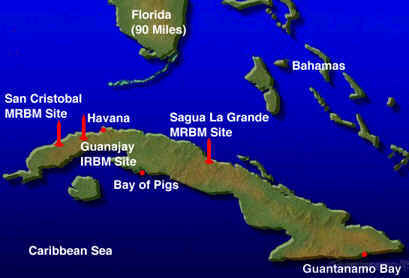 |  Kennedy sees Castro and Cuba as a threat to the United States so he authorizes
the invasion of Cuba anti-Castro Cubans. Kennedy sees Castro and Cuba as a threat to the United States so he authorizes
the invasion of Cuba anti-Castro Cubans.
The feud between the two men becomes personal and
assassination attempts were made. | BAY OF
PIGS
A plan to overthrow Castro
was presented to the new U.S. president, John F. Kennedy, soon after his inauguration in 1961. CIA
agents had been secretly training Cuban exiles (anti-Castro Cubans) to invade their homeland. They
thought the Cuban people would welcome such an invasion and rise up to overthrow Castro. Kennedy
agreed to the invasion plan -- but demanded crucial changes to hide U.S. involvement.
On April
15, 1961, six U.S. bombers disguised as Cuban aircraft took off from Nicaragua and attacked Cuban
airfields -- but caused only minimal damage. The next day, a CIA-trained force of 1,500 guerrillas
arrived at the Bay of Pigs, 125 miles south of Havana. But their plans soon turned into disaster.
Kennedy, now faced with international condemnation for the bombing, canceled additional air
support for the invasion. Castro's remaining air force quickly destroyed ships carrying vital
ammunition supplies for the invaders. Without American air support or supply, the invasion force was
quickly outnumbered and outmaneuvered. All of the invaders were captured or dead within 72 hours.
| | |
|
|
|
10.
|
Who was President of the U.S.
during the Cuban Bay of Pigs invasion. He approved the invasion.
a. | Dwight
Eisenhower | c. | Lyndon
Johnson | b. | John Kennedy | d. | Harry Truman |
|
|
|
11.
|
Why did the Bay of Pigs
invasion fail?
a. | the U.S. did not provide air support
for the anti-Castro forces, as promised | d. | only a and c are correct | b. | the people did not revolt against Castro as
expected | e. | a, b, and c are
correct | c. | the invaders were short of supplies and
ammunition. |
|
|
|
12.
|
The people who did the fighting
at the Bay of Pigs were Cuban exiles. What is a Cuban exile?
a. | A Cuban, loyal to
Castro | c. | An anti-Castro Cuban living in
Cuba | b. | A Cuban who is pro-Castro but anti-U.S. | d. | An anti-Castro Cuban who left Cuba after Castro took
power. |
|
|
|
13.
|
The Bay of Pigs invasion made
President Kennedy look _____ and Fidel Castro look _____ .
a. | weak -
strong | c. | strong -
strong | b. | strong - weak | d. | weak - weak |
|
|
|
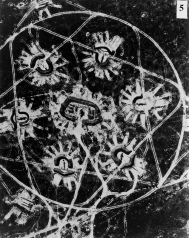
U2
Photograph showing Soviet Missile sites in Cuba |
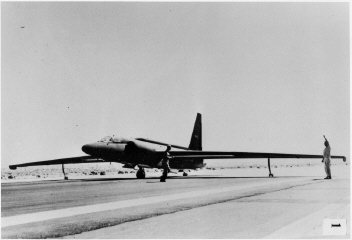 U2
Spy plane U2
Spy plane
Took photographs that warned the U.S.
| MISSILE CRISIS
The failure of the Bay of Pigs invasion did not keep the United States from
plotting new plans to get rid of Castro -- even assassination was carefully weighed. Cuba, meanwhile,
looked to Moscow for military support.
President Kennedy had allowed the Soviets to build the
Berlin Wall so Nikita Khrushchev did not respect Kennedy. Khrushchev offered to deploy Soviet
nuclear missiles in Cuba .and after initial resistance, Castro accepted the missiles. By July 1962,
the CIA had noticed an increase in Soviet ships heading for Cuba. By mid-October, U-2 spy planes
flying over Cuba brought back pictures of ballistic missile sites.
With nuclear warheads less
than 100 miles from the United States, the Soviets had the ability to strike any U.S. city without
warning. Kennedy formed a special inner cabinet of advisers -- the Executive Committee of the
National Security Council, or ExCom -- to weigh the options. Under consideration: a military invasion
to topple Castro and "surgical air strikes" against the missiles bases. But taking either
step without warning risked turning world opinion against the United States.
Another solution was
devised: The U.S. Navy would stop and search all ships heading for Cuba. Washington called it a
"quarantine." The Kennedy administration did not know how the Soviets would react if
Americans tried to stop and search Soviet ships. It could mean war.
| | |
|
|
|
14.
|
Why were Soviet missiles in
Cuba a threat to the U.S.
a. | The missiles in Cuba could strike
almost any city in the United States | c. | The missiles were not a threat because the U.S. could trust
Cuba | b. | If one of the missiles blew up by mistake it could destroy
Florida | d. | The missiles were not a threat because the U.S. could
trust the Soviets |
|
|
|
15.
|
How did the U.S. know the
Soviets were building offensive missile sites in Cuba?
a. | Castro bragged about the sites to
the world press | c. | The U.S. was
conducting U2 flights over Cuba | b. | Khrushchev told the U.S. as a warning | d. | Cuban spies were reporting the sites to the
CIA |
|
|
|
16.
|
What made the Soviets think
they could build offensive missile sites 90 miles from Florida without United States
interference?
a. | They knew Kennedy was afraid of
Khrushchev | c. | The U.S. did not
interfere when the Soviets built the Berlin Wall. | b. | The Soviets thought the United states would not learn
about the missiles | d. | The Soviets thought the United
Nations would approve |
|
|
|
17.
|
Kennedy formed a small group of
his most trusted advisors to help him solve the problem. The options they considered were
a. | invasion, negotiation,
Quarantine | c. | Quarantine,
suicide invasion, boycott | b. | invasion, air strikes, Quarantine | d. | attack on Russia, air strikes,
nothing |
|
|
|
AT THE BRINK
On October 22, President Kennedy told the world about the
discovery of Soviet missiles in Cuba and announced that a blockade was in force against all ships
bound for Cuba. Kennedy demanded the removal of the missiles from Cuba.
For several days the
world held its breath as the United States and Soviet Union appeared to be moving toward nuclear war.
Washington took its case to the United Nations and prepared for air strikes and a massive invasion of
Cuba.
Havana announced a "combat alarm" -- more than a quarter-million Cubans stood
ready to repel a U.S. invasion. Soviet forces on the island were equipped with nuclear-tipped
tactical missiles, ready to answer any invader.
In the United States, a wave of panic buying
swept across the country as people tried to prepare for a possible nuclear holocaust. And though
Soviet leaders tried to keep the crisis from their people, the news was leaking out, raising fears.
During and after the crisis many people had bomb shelters built in their yards and basements.
The
U.S. and the Soviets were headed for a show down. Soviet ships were heading for Cuba and Kennedy said
he would not let them through. If they tried to run the blockade there would be war. The world held
its breath.
|
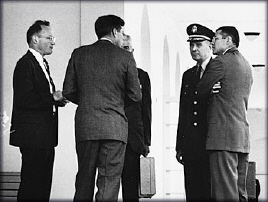
Kennedy Advisors -
What to do?
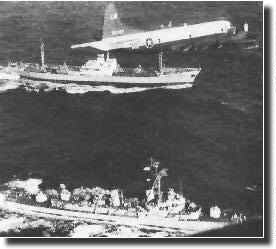 U.S. Planes Track Soviet Ships U.S. Planes Track Soviet Ships
If they try to
run the U.S. naval blockade there will be war between the Soviets and the
U.S. | | |
|
|
|
18.
|
Unlike his attitude toward the
Soviets for building the Berlin Wall, Kennedy’s attitude about he Cuban Missile Crisis was
a. | thoughtless | c. | soft | b. | unconcerned | d. | firm |
|
|
|
19.
|
The greatest danger of the
Cuban Missile was
a. | Loss of trade between the U.S. and
Cuba | c. | Communism might spread to the
U.S. | b. | Russia might invade Cuba | d. | Nuclear war might break out between the U.S, and the Soviet
Union |
|
|
|
20.
|
If you offer a carrot to a
horse (reward) and threaten him with a stick (punishment) at the same time it is called “carrot
and stick.” treatment. When you apply this idea to nations it is called “carrot and stick
diplomacy.” Who used “Carrot and Stick Diplomacy” in the Cuban Missile
Crisis?
a. | The Soviet
Union | c. | The United
States | b. | The Cuban government | d. | none of these |
|
|
|
21.
|
Which nations were ready for
war in the Cuban Missile Crisis?
a. | The U.S., Soviets and
Cuba | c. | The Soviets and
Cuba | b. | The U.S. and Soviets | d. | The Cubans and the U.S. |
|
|
|
22.
|
How did the American
people react to the Cuban Missile Crisis?
a. | Wild panic resulting in looting and
hysteria in both countries. | c. | Americans were not worried. | b. | Mild panic as people worried and stocked up on food and
water. | d. | Americans decided they would rather be Red than Dead.
(surrender to communism) |
|
|
|
| A WAY OUT
On October 26, with tensions increasing, Kennedy received
an offer from Khrushchev. The Soviet leader offered to withdraw his missiles from Cuba -- if the
United States promised never to invade the island. The next morning, Khrushchev added another
condition: the United States was to remove all its missiles from Turkey.
As Kennedy considered
the options, the crisis escalated again -- when a Soviet-led Cuban missile battery shot down a U-2
spy plane. The Pentagon was prepared to bomb the missile site, as contingency plans required -- but
Kennedy ordered that no action be taken. He wanted time to deal with Khrushchev.
The president
sent his brother, Attorney General Robert Kennedy, to meet with Soviet Ambassador Anatoly Dobrynin.
They struck a deal: Soviet missiles would be removed from Cuba in return for the unpublicized removal
of missiles from Turkey. On Sunday October 28, Khrushchev announced the withdrawal of the Soviet
missiles from Cuba. Under close American surveillance, Soviet ships took the missiles back home.
The crisis was over, but both sides were well aware how close they had come to nuclear
annihilation.
| |
|
|
|
23.
|
Khrushchev agreed to remove
Soviet missiles from Cuba if the U.S. .....
a. | removed its missiles from
Turkey | c. | promised not to invade
Turkey | b. | promised not to invade Cuba | d. | promised not to invade Cuba and removed its missiles from
Turkey |
|
|
|
24.
|
President Kennedy may have
seemed weak at the beginning of the Cuban Missile Crisis but by its end he showed that he was
a. | decisive | c. | strong | b. | diplomatic | d. | all of these |
|
|
|
25.
|
How many nuclear weapons were
used during the Cuban Missile Crisis?
|